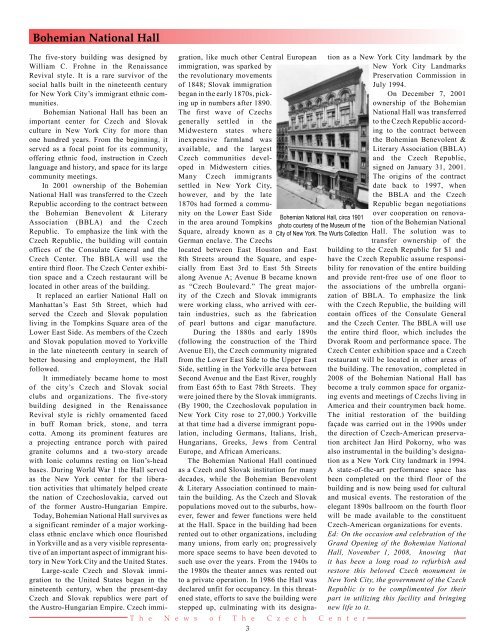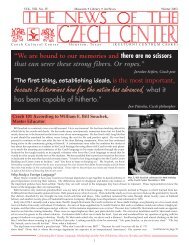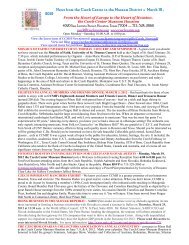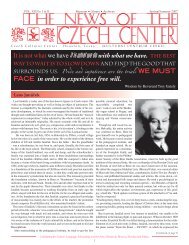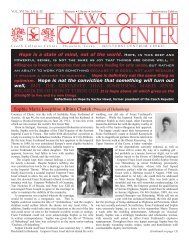If you lived as I did, several years under Nazi totalitarianism, and ...
If you lived as I did, several years under Nazi totalitarianism, and ...
If you lived as I did, several years under Nazi totalitarianism, and ...
Create successful ePaper yourself
Turn your PDF publications into a flip-book with our unique Google optimized e-Paper software.
Bohemian National Hall<br />
The five-story building w<strong>as</strong> designed by<br />
William C. Frohne in the Renaissance<br />
Revival style. It is a rare survivor of the<br />
social halls built in the nineteenth century<br />
for New York City’s immigrant ethnic communities.<br />
Bohemian National Hall h<strong>as</strong> been an<br />
important center for Czech <strong>and</strong> Slovak<br />
culture in New York City for more than<br />
one hundred <strong>years</strong>. From the beginning, it<br />
served <strong>as</strong> a focal point for its community,<br />
offering ethnic food, instruction in Czech<br />
language <strong>and</strong> history, <strong>and</strong> space for its large<br />
community meetings.<br />
In 2001 ownership of the Bohemian<br />
National Hall w<strong>as</strong> transferred to the Czech<br />
Republic according to the contract between<br />
the Bohemian Benevolent & Literary<br />
Association (BBLA) <strong>and</strong> the Czech<br />
Republic. To emph<strong>as</strong>ize the link with the<br />
Czech Republic, the building will contain<br />
offices of the Consulate General <strong>and</strong> the<br />
Czech Center. The BBLA will use the<br />
entire third floor. The Czech Center exhibition<br />
space <strong>and</strong> a Czech restaurant will be<br />
located in other are<strong>as</strong> of the building.<br />
It replaced an earlier National Hall on<br />
Manhattan’s E<strong>as</strong>t 5th Street, which had<br />
served the Czech <strong>and</strong> Slovak population<br />
living in the Tompkins Square area of the<br />
Lower E<strong>as</strong>t Side. As members of the Czech<br />
<strong>and</strong> Slovak population moved to Yorkville<br />
in the late nineteenth century in search of<br />
better housing <strong>and</strong> employment, the Hall<br />
followed.<br />
It immediately became home to most<br />
of the city’s Czech <strong>and</strong> Slovak social<br />
clubs <strong>and</strong> organizations. The five-story<br />
building designed in the Renaissance<br />
Revival style is richly ornamented faced<br />
in buff Roman brick, stone, <strong>and</strong> terra<br />
cotta. Among its prominent features are<br />
a projecting entrance porch with paired<br />
granite columns <strong>and</strong> a two-story arcade<br />
with Ionic columns resting on lion’s-head<br />
b<strong>as</strong>es. During World War I the Hall served<br />
<strong>as</strong> the New York center for the liberation<br />
activities that ultimately helped create<br />
the nation of Czechoslovakia, carved out<br />
of the former Austro-Hungarian Empire.<br />
Today, Bohemian National Hall survives <strong>as</strong><br />
a significant reminder of a major workingcl<strong>as</strong>s<br />
ethnic enclave which once flourished<br />
in Yorkville <strong>and</strong> <strong>as</strong> a very visible representative<br />
of an important <strong>as</strong>pect of immigrant history<br />
in New York City <strong>and</strong> the United States.<br />
Large-scale Czech <strong>and</strong> Slovak immigration<br />
to the United States began in the<br />
nineteenth century, when the present-day<br />
Czech <strong>and</strong> Slovak republics were part of<br />
the Austro-Hungarian Empire. Czech immi-<br />
gration, like much other Central European<br />
immigration, w<strong>as</strong> sparked by<br />
the revolutionary movements<br />
of 1848; Slovak immigration<br />
began in the early 1870s, picking<br />
up in numbers after 1890.<br />
The first wave of Czechs<br />
generally settled in the<br />
Midwestern states where<br />
inexpensive farml<strong>and</strong> w<strong>as</strong><br />
available, <strong>and</strong> the largest<br />
Czech communities developed<br />
in Midwestern cities.<br />
Many Czech immigrants<br />
settled in New York City,<br />
however, <strong>and</strong> by the late<br />
1870s had formed a commu-<br />
nity on the Lower E<strong>as</strong>t Side<br />
Bohemian National Hall, circa 1901<br />
in the area around Tompkins<br />
photo courtesy of the Museum of the<br />
Square, already known <strong>as</strong> a City of New York. The Wurts Collection<br />
German enclave. The Czechs<br />
over cooperation on renovation<br />
of the Bohemian National<br />
Hall. The solution w<strong>as</strong> to<br />
transfer ownership of the<br />
located between E<strong>as</strong>t Houston <strong>and</strong> E<strong>as</strong>t building to the Czech Republic for $1 <strong>and</strong><br />
8th Streets around the Square, <strong>and</strong> espe- have the Czech Republic <strong>as</strong>sume responsicially<br />
from E<strong>as</strong>t 3rd to E<strong>as</strong>t 5th Streets bility for renovation of the entire building<br />
along Avenue A; Avenue B became known <strong>and</strong> provide rent-free use of one floor to<br />
<strong>as</strong> “Czech Boulevard.” The great major- the <strong>as</strong>sociations of the umbrella organiity<br />
of the Czech <strong>and</strong> Slovak immigrants zation of BBLA. To emph<strong>as</strong>ize the link<br />
were working cl<strong>as</strong>s, who arrived with cer- with the Czech Republic, the building will<br />
tain industries, such <strong>as</strong> the fabrication contain offices of the Consulate General<br />
of pearl buttons <strong>and</strong> cigar manufacture. <strong>and</strong> the Czech Center. The BBLA will use<br />
During the 1880s <strong>and</strong> early 1890s the entire third floor, which includes the<br />
(following the construction of the Third Dvorak Room <strong>and</strong> performance space. The<br />
Avenue El), the Czech community migrated Czech Center exhibition space <strong>and</strong> a Czech<br />
from the Lower E<strong>as</strong>t Side to the Upper E<strong>as</strong>t restaurant will be located in other are<strong>as</strong> of<br />
Side, settling in the Yorkville area between the building. The renovation, completed in<br />
Second Avenue <strong>and</strong> the E<strong>as</strong>t River, roughly 2008 of the Bohemian National Hall h<strong>as</strong><br />
from E<strong>as</strong>t 65th to E<strong>as</strong>t 78th Streets. They become a truly common space for organiz-<br />
were joined there by the Slovak immigrants. ing events <strong>and</strong> meetings of Czechs living in<br />
(By 1900, the Czechoslovak population in America <strong>and</strong> their countrymen back home.<br />
New York City rose to 27,000.) Yorkville The initial restoration of the building<br />
at that time had a diverse immigrant popu- façade w<strong>as</strong> carried out in the 1990s <strong>under</strong><br />
lation, including Germans, Italians, Irish, the direction of Czech-American preserva-<br />
Hungarians, Greeks, Jews from Central tion architect Jan Hird Pokorny, who w<strong>as</strong><br />
Europe, <strong>and</strong> African Americans.<br />
also instrumental in the building’s designa-<br />
The Bohemian National Hall continued tion <strong>as</strong> a New York City l<strong>and</strong>mark in 1994.<br />
<strong>as</strong> a Czech <strong>and</strong> Slovak institution for many A state-of-the-art performance space h<strong>as</strong><br />
decades, while the Bohemian Benevolent been completed on the third floor of the<br />
& Literary Association continued to main- building <strong>and</strong> is now being used for cultural<br />
tain the building. As the Czech <strong>and</strong> Slovak <strong>and</strong> musical events. The restoration of the<br />
populations moved out to the suburbs, how- elegant 1890s ballroom on the fourth floor<br />
ever, fewer <strong>and</strong> fewer functions were held will be made available to the constituent<br />
at the Hall. Space in the building had been Czech-American organizations for events.<br />
rented out to other organizations, including Ed: On the occ<strong>as</strong>ion <strong>and</strong> celebration of the<br />
many unions, from early on; progressively Gr<strong>and</strong> Opening of the Bohemian National<br />
more space seems to have been devoted to Hall, November 1, 2008, knowing that<br />
such use over the <strong>years</strong>. From the 1940s to it h<strong>as</strong> been a long road to refurbish <strong>and</strong><br />
the 1980s the theater annex w<strong>as</strong> rented out restore this beloved Czech monument in<br />
to a private operation. In 1986 the Hall w<strong>as</strong> New York City, the government of the Czech<br />
declared unfit for occupancy. In this threat- Republic is to be complimented for their<br />
ened state, efforts to save the building were part in utilizing this facility <strong>and</strong> bringing<br />
stepped up, culminating with its designa- new life to it.<br />
T h e N e w s o f T h e C z e c h C e n t e r<br />
3<br />
tion <strong>as</strong> a New York City l<strong>and</strong>mark by the<br />
New York City L<strong>and</strong>marks<br />
Preservation Commission in<br />
July 1994.<br />
On December 7, 2001<br />
ownership of the Bohemian<br />
National Hall w<strong>as</strong> transferred<br />
to the Czech Republic according<br />
to the contract between<br />
the Bohemian Benevolent &<br />
Literary Association (BBLA)<br />
<strong>and</strong> the Czech Republic,<br />
signed on January 31, 2001.<br />
The origins of the contract<br />
date back to 1997, when<br />
the BBLA <strong>and</strong> the Czech<br />
Republic began negotiations


